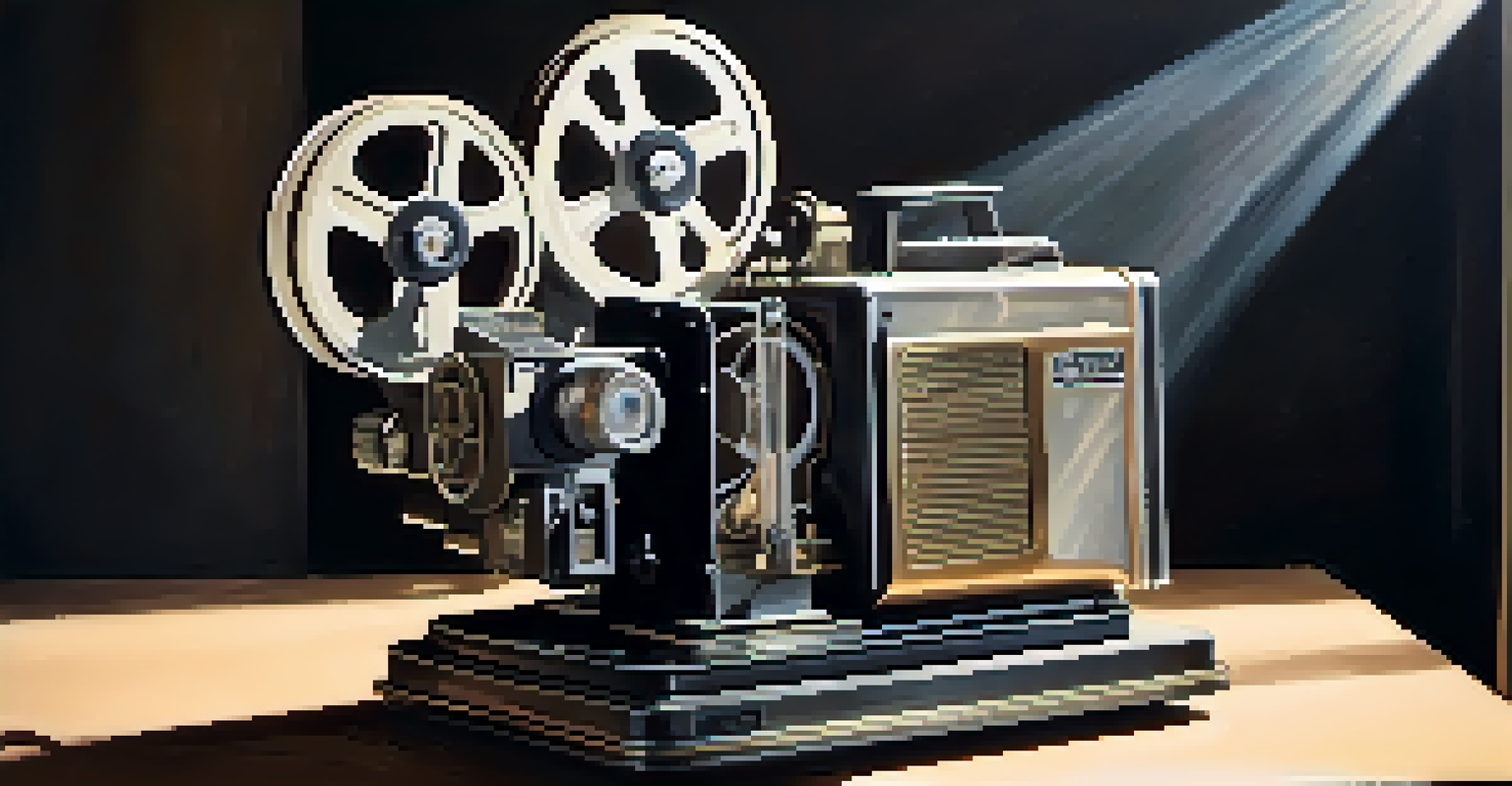Analyzing the Use of Silence in Film Soundtracks

The Role of Silence in Film Narratives
Silence in film is more than just the absence of sound; it plays a crucial role in storytelling. It can heighten emotions, create tension, or even provide relief. For instance, think about those moments in horror films where silence precedes a jump scare; the quiet amplifies the anticipation, making the eventual sound even more impactful.
Silence is a source of great strength.
Furthermore, silence can serve as a pause in dialogue, allowing characters to reflect or the audience to absorb a pivotal moment. This deliberate stillness can make scenes more profound, prompting viewers to engage actively with the narrative. A classic example is in movies like 'The Graduate,' where silence contributes significantly to its emotional depth.
Ultimately, silence is a powerful tool that filmmakers use to guide audience reactions. It can evoke introspection or provoke anxiety, depending on its placement within the film. By analyzing its use, we can appreciate how silence enhances the overall cinematic experience.
Psychological Impact of Silence on Audiences
Silence can evoke strong psychological responses, making viewers feel a range of emotions. For instance, in a dramatic scene, silence can create a sense of despair or loneliness, drawing the audience into the character's internal struggle. This emotional weight is often more potent than music or sound effects could convey.

Moreover, the use of silence can also make viewers more alert, sharpening their focus on the visuals or dialogue that follow. In films like 'A Quiet Place,' silence is not just a stylistic choice; it becomes a narrative device that shapes the plot. The absence of sound forces audiences to pay attention to every nuance.
Silence Enhances Emotional Impact
Silence in film can heighten emotions and create tension, making pivotal moments more profound.
By tapping into our innate reactions to silence, filmmakers can craft experiences that resonate deeply. This psychological manipulation of sound—or the lack thereof—can linger long after the credits roll, prompting viewers to reflect on what they just witnessed.
Cultural Interpretations of Silence in Film
Cultural contexts can significantly influence how silence is perceived in films. In some cultures, silence may be interpreted as respect or contemplation, while in others, it could signify discomfort. This diversity shapes how audiences respond to silence, making it a complex element of storytelling.
In the silence, you can hear the truth.
For instance, Japanese cinema often uses silence to create a meditative atmosphere, allowing viewers to engage with the film on a deeper level. Films like 'Spirited Away' utilize quiet moments to immerse the audience in the character's journey, highlighting the beauty of stillness in storytelling.
Understanding these cultural nuances can enhance our appreciation for how silence is used in different films. It invites us to consider not only what we hear but also what we don’t, expanding our interpretation of the narrative.
Silence as a Contrast to Sound in Film
Silence is often employed as a stark contrast to sound, enhancing the overall impact of a film's soundtrack. Imagine a loud, chaotic scene suddenly cutting to silence; this juxtaposition can be jarring and memorable. It forces the audience to confront the emotional weight of the moment.
For example, in 'No Country for Old Men,' the strategic use of silence during tense scenes heightens the suspense. When the sounds of violence and chaos dissipate, it emphasizes the gravity of the situation, allowing viewers to feel the tension palpably.
Cultural Views Shape Silence's Role
Cultural contexts influence how silence is interpreted in film, affecting audience engagement and narrative understanding.
By utilizing silence as a counterpoint to sound, filmmakers can create dynamic shifts in mood and tone. This contrast not only captivates the audience but also reinforces key themes within the narrative.
Technical Aspects of Incorporating Silence
From a technical standpoint, incorporating silence into a film's soundtrack involves careful planning and execution. Sound designers must consider how silence interacts with both diegetic sounds (those that occur naturally within the film's world) and non-diegetic sounds (like the score). This balance is crucial for achieving the desired emotional impact.
For instance, filmmakers might choose to fade out the music gradually before a silent moment, creating a smooth transition that feels intentional. This technique can be particularly effective in building suspense or emphasizing a character's emotional state.
Ultimately, the technical execution of silence requires a deep understanding of sound design principles. By skillfully incorporating silence, filmmakers can enhance storytelling and create memorable cinematic moments.
Iconic Film Examples Featuring Silence
Many iconic films have effectively utilized silence to leave a lasting impression on audiences. Take 'The Godfather,' for example; the moments of silence in pivotal scenes amplify the gravity of the narrative and character decisions. These pauses allow viewers to absorb the weight of the story without distraction.
Similarly, 'The Artist,' a silent film, showcases the power of absence in sound, proving that silence can be a compelling storytelling device. The film's use of silence enhances its emotional depth, inviting audiences to engage with the visuals and characters in a unique way.
Silence Contrasts with Sound Dynamics
Utilizing silence as a contrast to sound amplifies emotional weight and reinforces key themes in storytelling.
Highlighting these examples underscores the versatility of silence in film. As viewers, we can learn to appreciate these moments as integral components of the storytelling process.
Future Trends in Film Soundtrack Design
As technology evolves, filmmakers are finding new ways to play with silence in their soundtracks. With advancements in sound design and editing tools, the possibilities for incorporating silence are expanding. This could lead to innovative storytelling methods that challenge traditional norms.
For instance, filmmakers may experiment with immersive soundscapes, where silence is strategically placed to enhance the audience's emotional journey. This trend could redefine how we perceive both silence and sound in cinema, making for a more engaging experience.

Looking ahead, it will be fascinating to see how filmmakers continue to navigate the complexities of sound and silence. As audiences become more attuned to these subtleties, the impact of silence in film soundtracks will likely grow even more significant.